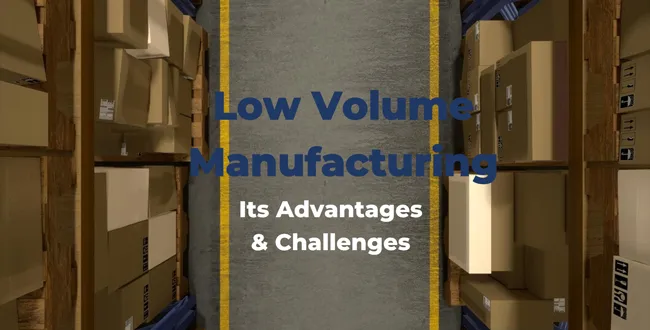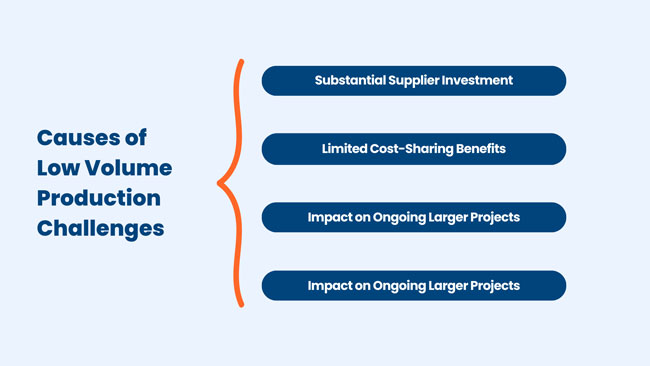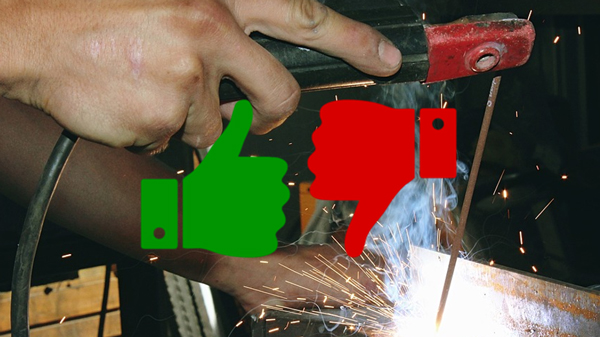What Is Low Volume Manufacturing: Its Advantages & Challenges
- Date:
- Author: SVI Content Team
- Share:
Every company dreams of hitting the jackpot with a massive order. It’s widely known that the effort put into a small order isn’t vastly different from a larger one. So, naturally, the allure of those substantial contracts is irresistible.
Orders of low volume manufacturing ascend as the prevailing trend. McKinsey reports point out that product customization and faster time-to-market are key competitive drivers, fueling the demand for agile production models like small batch production.
Yet many teams still wrestle with when to use it, how it differs from high-volume runs, where to source reliable partners, and how to overcome its challenges to leverage its full potential.
To clear up your questions, this guide cuts through the complexity and offers facts on the benefits of small batch production, its challenges, and practical solutions to turn them into competitive advantages.
Part 1. What Is Low Volume Manufacturing?
✔ Definition:
Low volume manufacturing refers to the process of producing goods in limited quantities. The volume typically ranges from as few as 10-50 units up to 10,000 units annually, though the exact range varies by industry and product complexity.
✔ Key characteristics:
It prioritizes flexibility and responsiveness over the large scale economies of high volume production.
- Flexible production
- Quick turnaround
- Lower minimum order quantity (MOQ) for small orders
- Cost-effective investment
- Suitable for custom or evolving designs
✔ Low vs Mass Production:
| Feature | Low Volume Production | Mass Production |
|---|---|---|
| Order Size | 10 to 10,000 units | Thousands or millions of units |
| Setup Time | Short | Long |
| Setup Cost | Lower relative to volume | High (amortized over huge volumes) |
| Cost/Unit | Higher | Low |
| Focus | Flexibility, Customization, Speed | Maximum Efficiency, Lowest Cost/Unit |
| Changeovers | Frequent, easier | Infrequent, costly & complex |
| Best For | Niche markets, startups, prototypes, custom parts, rapid innovation | Commodities, established high-demand products |
Part 2. When Is a Small-Batch Production Right for You?
What scenario would necessitate a small order size? Check out the key triggers and the benefits of small batch production.
1. New Product Introduction & Testing
Small batches are often used for prototyping and testing new products before scaling up to larger volumes.
This allows you to refine the design, assess market acceptance, and identify any potential issues or improvements before going to mass production.
⭕ Advantages of Low Volume Production:
- Mitigate mistakes and risks
- Gather feedback from the market
- Iteratively improve product design and quality
2. Customized Requests
Customers today are increasingly seeking personalized and tailored products, especially in fashion, consumer goods, and electronics.
⭕ Advantages of Low Volume Production:
- Respond swiftly to customer preferences and market trends faster
- Avoid dead inventory
- Cater to unique individualized customer requests efficiently
3. Small Businesses
If you are a small company, particularly startups or those focusing on small or niche markets, smaller production can help you meet the target market and release financial strains.
⭕ Advantages of Low Volume Production:
- Lower financial risk
- Less inventory pressure
- Avoid large upfront costs
4. Seasonal Products
Items with short demand windows, like Halloween and Christmas items, back-to-school supplies, or seasonal apparel, are suitable for small batch production.
⭕ Advantages of Low Volume Production:
- Avoid overproduction and leftover stock
- Align demand based on pre-orders or early sales data
5. Supply Chain Diversification
There are always unforeseen disruptions in the supply chain, and to avoid or mitigate the effects of those, companies often split orders across regions. Low volume manufacturing can help minimize the risk and build new supplier networks safely.
⭕ Advantages of Low Volume Production:
- Reduce dependency on a single region
- Limit financial loss in case of disruption
- Enable agile sourcing and quicker response times
Part 3. Common Challenges of Low-volume Manufacturing
Small-batch manufacturing is a production that produces goods in few quantities. It can present challenges for customers who seek efficient sourcing solutions.
1. Low Bargaining Power
One of the challenges of low-volume orders is a reduced ability to negotiate favorable terms. With orders that don’t boast significant volume, you may find yourself with diminished leverage to drive prices down because suppliers are less likely to offer preferential rates or flexible terms for orders with smaller quantities.
2. Limited Supplier Options
Unlike larger-scale sourcing, where a plethora of suppliers might compete for orders, small-batch sourcing can lead to a scarcity of viable options.
Suppliers might prioritize bulk orders over smaller ones, limiting the pool of partners willing to fulfill lower-volume requests. This scarcity can hinder you from getting a reliable and suitable provider.
3. Lengthy Delivery Times
Low volume production might not be at the forefront of manufacturers’ production schedules. This can result in longer lead times.
More: There are more details about how to reduce lead times in sourcing.
4. Challenging Quality Control
With quantities too limited to warrant the initiation of dedicated production molds, manufacturers often resort to sample molds that deviate in material composition from regular production molds.
Quality consistency is harder to maintain with no established production routine or dedicated molds.
5. Inadequate Infrastructure
Suppliers with established infrastructure for large and standardized orders are sometimes not suitable for small and customized orders.
The lack of a setup or experience for orders with low quantity can cause an inefficient and impractical process.
Part 4. How to Resolve Challenges of Low Volume Manufacturing
Now that you know the obstacles, here’s how you can take to turn them into opportunities.
1. Select Suitable Suppliers and Foster Partnerships
Choose suppliers who specialize in dealing with small batch manufacturing. Factories that offer a low MOQ are usually equipped with capabilities to meet your demands.
Pro Tip:
- Use sourcing platforms like Alibaba that directly connect suppliers and buyers and allow filtering by MOQ.
- Search for terms like “prototype to production,” “short runs,” “low volume,” “custom manufacturing” online, and prioritize these suppliers.
- Visit regional trade fairs like the Canton Fair in China.
- You can also work with a sourcing agent to shortlist suitable partners.
- Consider domestic or nearshore sourcing. Sourcing closely can offer advantages in communication and lead times.
2. Establish Communication and Collaboration
Build an open channel for communication and foster a continuous partnership. It helps get across all the product requirements and expectations, so as to better manage the production process and address the challenges of small batch manufacturing.
3. Reduce Extensive Customization and Optimize Costs
For low-volume orders, optimal resolution lies in fostering collaboration among design, procurement, and production teams.
Teams can minimize non-standard components by adopting a modular design structure and then unify auxiliary materials and tooling into a standardized model. This can reduce setup costs and facilitate sourcing.
Part 5. Why Is It Difficult to Find Suppliers with Low MOQs?
Many suppliers hesitate to accept low volume orders. Let’s see from the supplier’s perspective.
1. Substantial Supplier Investment
One of the primary reasons behind the hurdles in small-batch procurement lies in the substantial upfront investment required from suppliers.
Developing a new product involves costs of design, development, molds, and labor. It is challenging to recoup the initial investment if no further collaboration.
2. Limited Cost-Sharing Benefits
Cost-sharing, which benefits both suppliers and clients in larger orders, becomes less feasible in the context of small-batch procurement.
When costs (e.g., mold making) are fixed, in bulk orders, costs can be spread over numerous units, thus reducing unit costs.
However, the cost-saving advantage of dividing these costs is minimal and not cost-effective because of low quantities.
3. Impact on Ongoing Larger Projects
Suppliers typically distribute resources and capacity based on projected order volumes and schedules.
Meeting the demands of small batch production often requires suppliers to allocate resources and attention away from larger and more lucrative projects. This shift in priorities will affect their overall strategy and profitability.
4. Impact on Profit Margins
It’s often harder for suppliers to achieve their desired profit margins on low-volume work compared to large-scale production.
As a result, suppliers might quote higher prices for small orders to compensate for the perceived opportunity cost of diverting resources from more profitable ventures.
Conclusion
Low volume manufacturing, also known as small batch production, is given paramount importance in dynamic markets. Various triggers drive the need for low-volume manufacturing. In the case of multiple demands, the low volume production satisfies you well and gives you various advantages
However, it is wise to consider the challenges encounter in small-batch orders. These challenges include low bargaining power, lengthy delivery times, production inefficiency and many more. To overcome these obstacles, you should understand the causes behind them as illustrated in the previous text.
Additionally, collaborating with industry experts like SVI Global can provide valuable guidance and support in addressing your concerns in low volume production. With our rich experience in the supply chain, we are more than willing to guide you through obstacles and help steer your business toward success.








